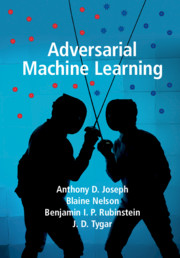Book contents
- Frontmatter
- Contents
- List of Symbols
- Acknowledgments
- Part I Overview of Adversarial Machine Learning
- 1 Introduction
- 2 Background and Notation
- 3 A Framework for Secure Learning
- Part II Causative Attacks on Machine Learning
- Part III Exploratory Attacks on Machine Learning
- Part IV Future Directions in Adversarial Machine Learning
- Part V Appendixes
- Glossary
- References
- Index
1 - Introduction
from Part I - Overview of Adversarial Machine Learning
Published online by Cambridge University Press: 14 March 2019
- Frontmatter
- Contents
- List of Symbols
- Acknowledgments
- Part I Overview of Adversarial Machine Learning
- 1 Introduction
- 2 Background and Notation
- 3 A Framework for Secure Learning
- Part II Causative Attacks on Machine Learning
- Part III Exploratory Attacks on Machine Learning
- Part IV Future Directions in Adversarial Machine Learning
- Part V Appendixes
- Glossary
- References
- Index
Summary
Machine learning has become a prevalent tool in many computing applications. With the rise ofmachine learning techniques, however, comes a concomitant risk. Adversaries may attempt to exploit a learning mechanism either to cause it to misbehave or to extract or misuse information.
This book introduces the problem of secure machine learning; more specifically, it looks at learning mechanisms in adversarial environments. We show how adversaries can effectively exploit existing learning algorithms and discuss new learning algorithms that are resistant to attack. We also show lower bounds on the complexity of extracting information from certain kinds of classifiers by probing. These lower bound results mean that any learning mechanism must use classifiers of a certain complexity or potentially be vulnerable to adversaries who are determined to evade the classifiers. Training data privacy is an important special case of this phenomenon.We demonstrate that while accurate statistical models can be released that reveal nothing significant about individual training data, fundamental limits prevent simultaneous guarantees of strong privacy and accuracy.
One potential concern with learning algorithms is that they may introduce a security fault into systems that employ them. The key strengths of learning approaches are their adaptability and ability to infer patterns that can be used for predictions and decision making. However, these advantages of machine learning can potentially be subverted by adversarial manipulation of the knowledge and evidence provided to the learner. This exposes applications that use machine learning techniques to a new class of security vulnerability; i.e., learners are susceptible to a novel class of attacks that can cause the learner to disrupt the system it was intended to benefit. In this book we investigate the behavior of learning systems that are placed under threat in security-sensitive domains. We will demonstrate that learning algorithms are vulnerable to a myriad of attacks that can transform the learner into a liability for the system they are intended to aid, but that by critically analyzing potential security threats, the extent of these threats can be assessed and proper learning methods can be selected to minimize the adversary's impact and prevent system failures.
We investigate both the practical and theoretical aspects of applying machine learning to security domains in five main foci: a taxonomy for qualifying the security vulnerabilities of a learner, two novel practical attacks and countermeasure case studies, an algorithm for provable privacy-preserving learning, and methods for evading detection by a classifier.
- Type
- Chapter
- Information
- Adversarial Machine Learning , pp. 3 - 19Publisher: Cambridge University PressPrint publication year: 2019



